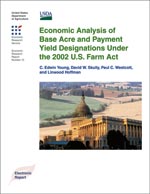Economic Analysis of Base Acre and Payment Yield Designations Under the 2002 U.S. Farm Act
- by Edwin Young, David W. Skully, Paul Westcott and Linwood Hoffman
- 9/19/2005
Overview
The 2002 Farm Act provided farmland owners the opportunity to update commodity program base acres and payment yields used for calculating selected program benefits. Findings in this report suggest that farmland owners responded to economic incentives in these decisions, selecting those options for designating base acres that resulted in the greatest expected flow of program payments. Farmland owners with high-payment base acres, such as rice and cotton, held on to these base acres and, whenever possible, expanded them. Analogously, farmland owners with low-payment commodity base acres, such as oats and barley, switched to higher payment commodities whenever possible.
Download
-
Entire report
Download PDF -
Report Summary
Download PDF -
Abstract, Acknowledgments, Contents, and Summary
Download PDF -
Introduction
Download PDF -
Role of Base Acres and Program Yields in U.S. Agricultural Policy
Download PDF -
Planting Flexibility Allowed Movement Away From Base Acres
Download PDF -
The 2002 Farm Act
Download PDF -
Economics of Base Designation
Download PDF -
Evaluating the Base Updating Decision
Download PDF -
Influence of Base Updating on 2003 Planting Decisions
Download PDF -
Conclusions
Download PDF -
References
Download PDF -
Appendix
Download PDF

